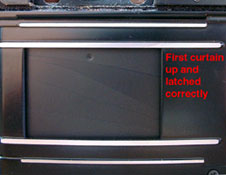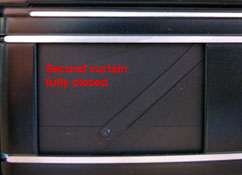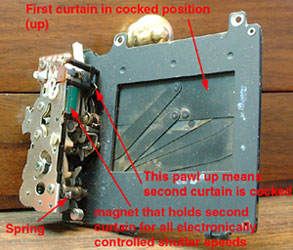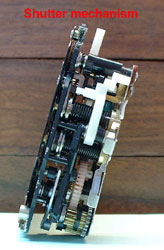|
Three common failure problems of the ME Super come to mind:
1. Over zealous winding

A. Winding too hard, especially at the end of the wind stroke, can
shear off the tab shown below. If this is the problem the wind lever
will move freely until it wedges into the other components under the
frame counter plate.
And… you’ll be in for some serious disassembly.

B. Winding too hard when the wind lock isn’t released will
bend the wind lock catch. You’ll know it is bent if the wind
lever can be wound, then wound again without releasing the shutter.
But luckily it can usually be bent right back in position without
permanent damage.
A properly adjusted wind lock is shown in the released position. If
the tip angles more towards the back of the camera (up in the photo)
or the curved inner part of the catch doesn’t set flush on the
crank cam, it needs rebending.
Holding the wind lock disengaged while winding the camera is
known as “resetting”. Resetting should be the first thing
tried when a camera locks up because it puts everything into a pre shutter
release position. Sometimes holding the mirror in an up (or down) position
while resetting is advantageous.
DO NOT TOUCH THE SILVERED MIRROR SURFACE.
2. The release cycle not completed
—not all the
dominoes fell down.
Drag in the curtain mechanism will cause the curtains to slow down.
When really bad the second curtain may not descend with enough momentum
to trigger the release of the mirror. Cleaning of the shutter and mirror
mechanisms are usually required. But other things may also cause the
problem. For instance a film chip may get into the curtain track. Pushing
the curtain down with the tip of a fingernail may be all that is required
to complete the cycle and allow the mirror to drop.
Whatever you do—DO NOT squirt oil or WD-40 on the blades
or ANYPLACE in the camera for that matter. Very little lube is needed
in a camera.



Many inexperienced tinkerers will increase the curtain tension, (especially
on the easy to access curtain tensioners on cloth style horizontal travel
curtains) but this isn’t the best way to fix the problem. In fact,
it often will cause uneven curtain speeds and therefore uneven frame
exposure. Once the mechanism is cleaned the factory tension setting
usually brings the curtain speeds back up to par.
I have had some luck setting the assembled body with the wind side
down and squirting in some Ronsonol. Only the bottom cover need be removed.
I don’t recommend this as who knows where the dirt and dried lube
may go. Even worse problems might be created. The only real way to fix
slow curtains is to remove the mirrorbox and simply clean out the dirt
and old, dried lubricants with Ronsonol. The shutter assembly itself
can remain in the camera body. Seriously, the mirrorbox isn’t
that hard to remove to do the job right.
3. The camera auto-releasing.
This can be caused by different things, but the most common cause is
probably the main cocking lever not latching. Often one of three things
may cause this.
A. The main cocking lever isn’t being stroked far enough during
cocking because the lever that pushes the main cocking stub has bent
over time. This lever is fairly thin and can bend easily. This lever
is pointed out in a previous photo.
To bend it back in place remove the slide mechanism under the bottom
cover. Only three screws hold it. It comes off cleanly. There are previous
photos showing this mechanism both on and off. The part that usually
bends is the section closest to the stub itself.
B. If the camera auto-releases right side up, try turning it upside
down. If it then winds and releases normally, the spring shown to
the left has fallen off the lever.

This is the lever that the mirror mechanism engages (step 4 in the
photo) to release the first curtain. Without the spring attached the
first curtain will not latch when the camera body is right side up.
This spring is real easy to knock off when reinstalling the mirrorbox.
C. If the pawl shown here doesn’t latch when being cocked it
will release the main cocking lever as the wind lever is being returned.
Dirt can cause this but so can a bent slide arm. The slide arm is
the crank arm looking gizmo under the bottom cover. When it is bent
it doesn’t pull the shutter cocking lever far enough to latch
the second curtain.


Also the white plastic levers can stick and prevent the second curtain
from latching. But this isn’t real common.
The green electro-magnet (seen mounted inside the shutter mechanism),
when powered, holds the second curtain until the electronic timer runs
out. All shutter speeds visible in the viewfinder are electronic. Even
when the mode dial is set to manual the speeds are still electronic.
They are all run by the same electronic timer circuit. But in all other
respects the mechanical dominoes fall consecutively.
|








